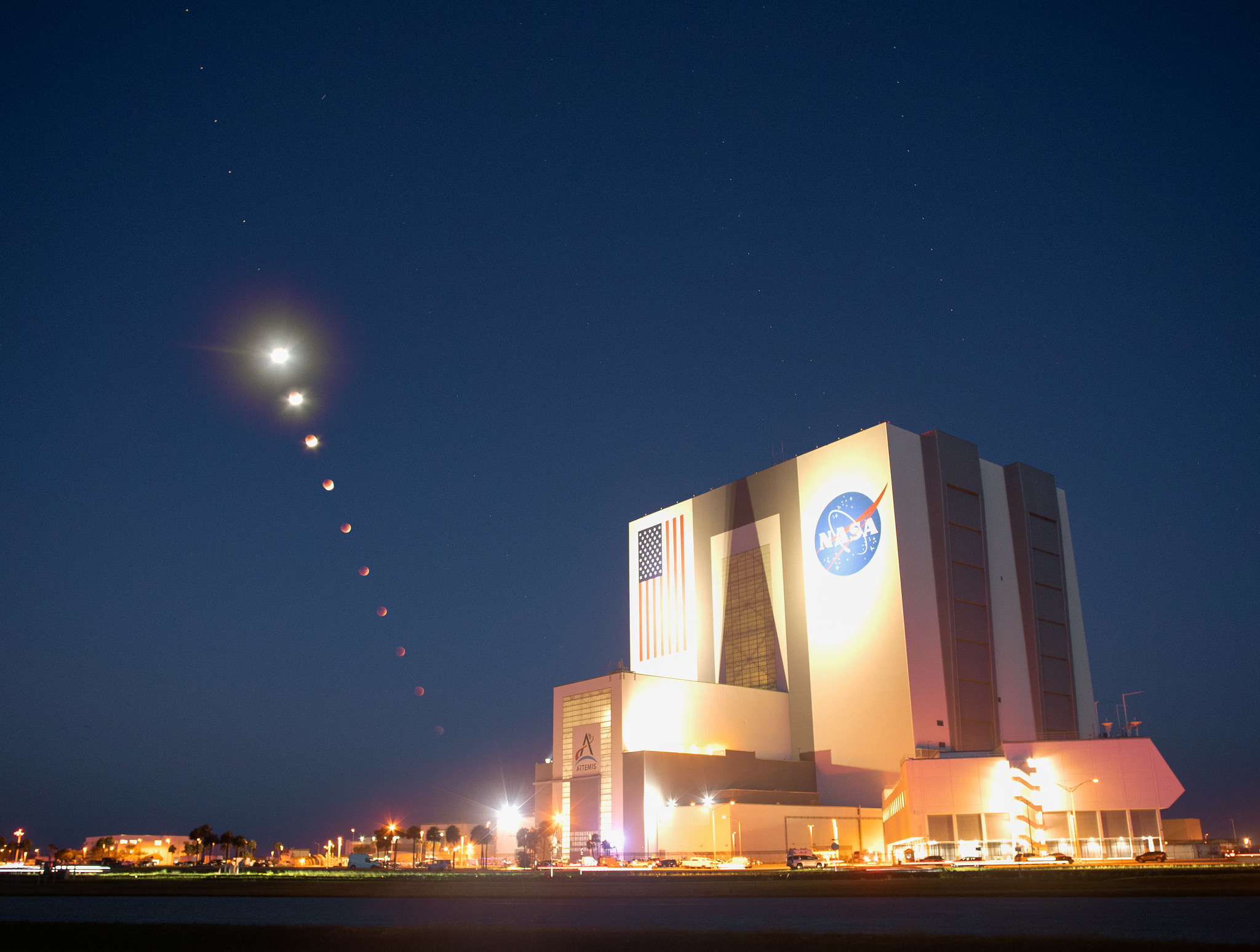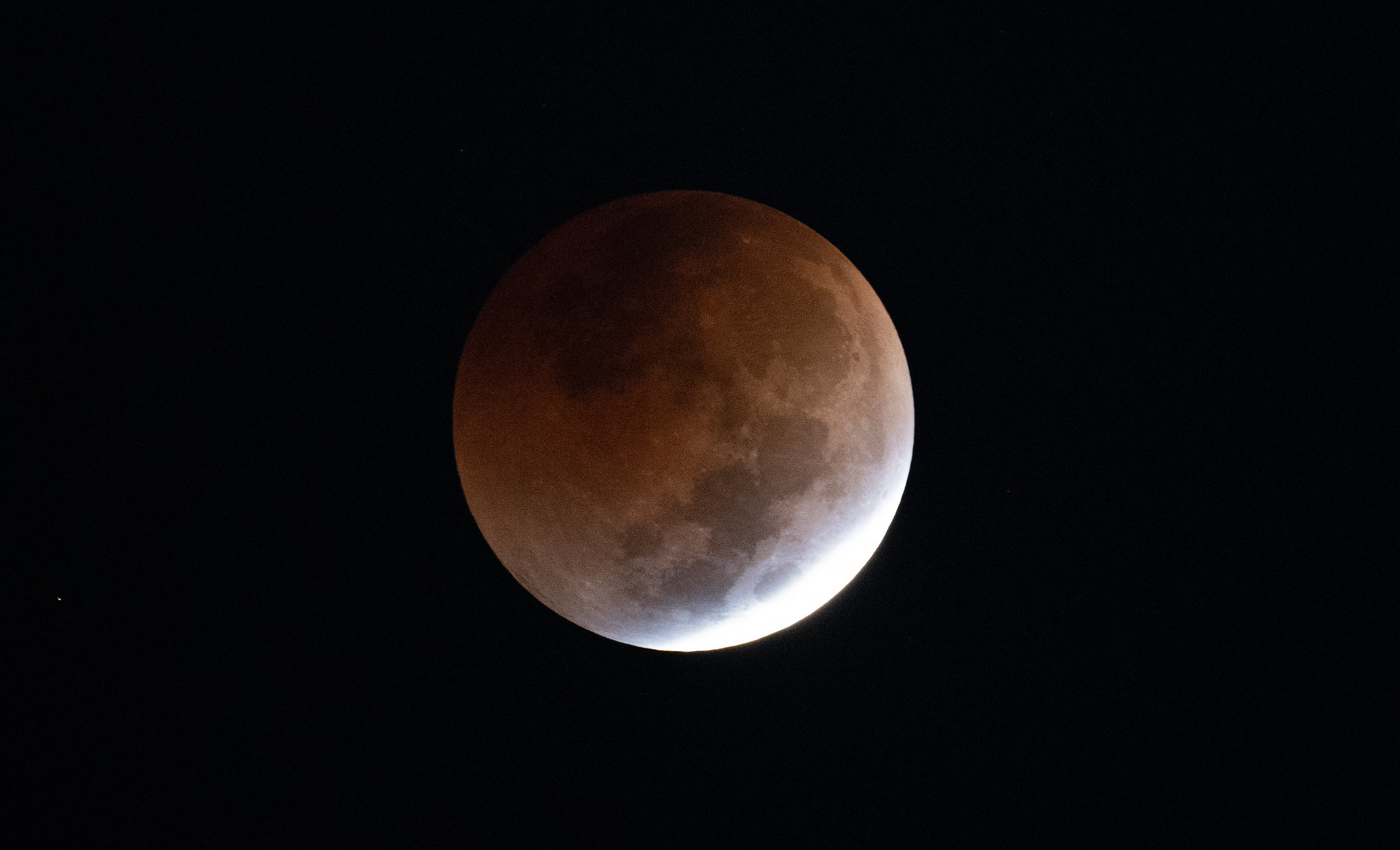CAPE CANAVERAL, Fla. — NASA’s huge Artemis 1 moon rocket stares up at its blood-red target in amazing photos posted by the space agency today (Nov. 8).
The Beaver Blood Moon lunar eclipse, the last total lunar eclipse until 2025, thrilled skywatchers around the world this morning — including people here on Florida’s Space Coast, which hosts Cape Canaveral Space Force Station and NASA’s Kennedy Space Center (KSC).
One of those folks was NASA photographer Joel Kowsky, who snapped a series of dramatic shots showing the blood-red moon rising above the agency’s huge Artemis 1 rocket, which has been sitting on KSC’s Launch Pad 39B since Friday (Nov. 4).
Related: Amazing photos of the last Blood Moon lunar eclipse of 2022 (gallery)
(opens in new tab)
Riding out the storm
Artemis 1, the first mission of NASA’s Artemis program, will use the agency’s Space Launch System (SLS) rocket to send an uncrewed Orion capsule on a 26-day mission to lunar orbit and back. NASA intends to launch Artemis 1 on Nov. 14, though Mother Nature must cooperate with that plan — and the weather over the next few days does not look good.
The U.S. National Hurricane Center (NHC) issued hurricane and storm surge watches for Florida’s east coast on Monday (Nov. 7). A weather pattern called Invest 98L formed in the Atlantic Ocean over the past week and developed into Subtropical Storm Nicole on Monday morning, according to the NHC, and is expected to reach the Space Coast as early as Wednesday (Nov. 8).
This storm comes on the heels of Hurricane Ian, which devastated parts of Florida in late September. Hurricane Ian’s approach prompted NASA to cancel the previous Artemis 1 launch attempt and roll the rocket off Pad 39B and back to KSC’s Vehicle Assembly Building (VAB) for safekeeping. In the face of Nicole, however, NASA is choosing to leave the rocket at the pad.
“Based on current forecast data, managers have determined the Space Launch System rocket and Orion will remain at Launch Pad 39B,” NASA wrote in a statement Monday, adding that officials “will evaluate the status of the Monday, Nov. 14, launch attempt for the Artemis 1 mission as we proceed and receive updated predictions about the weather.”
The agency’s decision to proceed toward a Nov. 14 launch is not wholly unexpected. Current models predict that Nicole will arrive on Florida’s east coast sometime Wednesday, bringing heavy rains and winds that could reach tropical-storm-force speeds by Friday (Nov. 11).
However, the storm is projected to be gone by the time of Monday’s launch attempt, and, provided that Nicole doesn’t damage the Artemis 1 stack or KSC ground systems, NASA will continue gearing up for launch.
Related: NASA’s Artemis 1 moon missions: Live updates

The agency is also diligently preparing for a potential hurricane, should Nicole strengthen into one. NASA works closely with the U.S. Space Force’s 45th Weather Squadron to outline alert level protocols for KSC and Patrick Space Force Base. Currently, KSC is under what’s known as HURCON III. HURCON III is put into effect 48 hours before sustained winds of 50 knots (57.5 mph, or 92.6 kph) are expected to reach the space center.
The Artemis 1 rocket is rated to withstand wind gusts of up to 74.1 knots (85 mph, or 136.8 kph). So far, Nicole is not expected to achieve winds that strong, which explains why NASA decided to leave SLS and Orion at the pad rather than roll the duo back to the VAB. However, Nicole still has the potential to push the launch attempt to one of the immediate backup days, Nov. 16 or Nov. 19.
Nicole has already disrupted NASA’s plans to some degree in the days leading up to the Artemis 1 launch. Certain actions are taken when a facility is at HURCON III status, for example, including “securing facilities, property and equipment, as well as briefing and deploying the ROT [ride-out team],” according to NASA’s hurricane-preparedness page (opens in new tab). This inevitably requires the prioritization of certain operations at KSC over others.

A rare opportunity canceled
Other photographers would have joined NASA’s Kowsky in documenting the dramatic juxtaposition of Artemis 1 and the Blood Moon on Tuesday morning, had Nicole not spoiled the party.
NASA invited a handful of press to KSC to photograph the rare event. The eclipse occurred close to the time of moonset, so a westward view of Artemis 1 was the only vantage point from which to align such a shot. And the only location outside of restricted areas at KSC for such a perspective would be from the Atlantic Ocean, whose seas are growing choppier as Nicole approaches.
I was one of the invitees, and I cannot emphasize enough how incredible this opportunity was. An SLS rocket will likely stand at Pad 39B just a dozen or so times over the next 20 years (and that is a generous estimate). NASA recently ordered additional Orion spacecraft to facilitate Artemis missions six through eight, which are expected to launch in the 2030s. Artemis 2 is expected to launch in 2024, but delays already suggest that date might slip.
This is all to say, the moon setting behind an Artemis rocket standing on the launch pad during a total lunar eclipse is not something that is likely to happen again soon, or very often, if ever again at all. It was incredibly generous of NASA to invite photographers to such an occasion.
Unfortunately, KSC’s HURCON status prevented credentialed media from attending as planned, prompting NASA officials to cancel the photoshoot altogether. And it is not the only schedule change as a result of Nicole’s impending arrival.
For example, NASA informed media photographers via email on Monday that remote-camera setups for the Artemis 1 launch would also be rescheduled, “once more is known about weather clearances at the center.” And while ensuring pretty photos of the Nov. 14 launch is low on the priority of NASA’s launch-readiness checklist, it is likely not the only scheduled preparation getting waylaid by the storm. We’ll just have to see what Nicole has in store for the U.S. East Coast.
Editor’s Note: If you snapped an amazing lunar eclipse photo and would like to share it with Space.com’s readers, send your photo(s), comments, and your name and location to [email protected].
Follow us on Twitter @Spacedotcom (opens in new tab) or on Facebook (opens in new tab).

